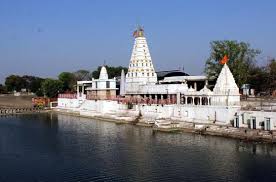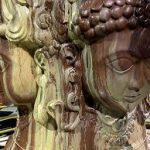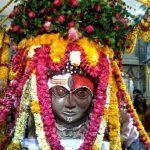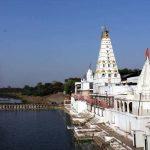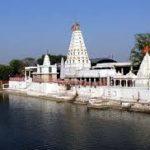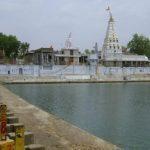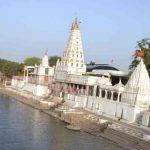Pashupatinath Temple, Mandsaur, Madhya Pradesh
| Date built: | – |
|---|---|
| Deity: | – |
| Architectural style: | – |
| Major festivals | – |
| Locale: | – |
| District:: | Mandsaur |
| Address: | Pashupatinath Mandir Road, Mandsaur, Madhya Pradesh 458001 |
| Phone | 07422205288 |
The Shiv Ling in the temple is 8′ x 10.5′ and weighs 4.6 tons. The temple built on the river is 90 feet long, 30 feet wide and 101 feet tall. On top of the temple is a 100 kg gold plated pitcher. Every monsoon the water level in the Shivna river rises to touch the holy Shiv Ling of lord Shiva. This phenomenon is termed as “Jalaabhishek” which means worshiping god through the water.
Gradually the idols of other Hindu gods such as goddess Maata Paarvati, Ganesha, Kartikeya, goddess Maata Ganga, Vishnu, goddess Maata Lakshmi and Saint Adyashankaracharya were established within the temple with a huge idol of Nandi Maharaaj facing the west face of the idol Lord Pashupatinath with eight-faced.
According to the Hindu mythology, the temple of Pashupatinath was constructed many centuries ago. It is said that the Shiv Ling emerged from the waters of the Shivna on Monday, which is considered as an auspicious day by the devotees of Lord Shiva. On Sunday, it reached the Tapeshwar Ghat of the river and was placed there. On Monday, after exactly, 21 years, 5 months and 4 days it was incarnated. The day of incarnation of the idol is celebrated as a Mela in the area surrounding the temple.
The Temple is open from 06:00 AM to 8:00 PM (All days of the week). The climate condition in Mandsaur is changeable. It means, during winters temperature dropping down to 32 to 14 degree Celsius while in summers it rises to 34 to 44 degree Celsius. However, monsoon occurs especially in the month of July that offers good rainfall. So the best time to get there is from October to March.
Architecture
Madhya Pradesh or the ‘Heart of Incredible India’ is the home to the cultural heritage of the sub-continent. From monuments with intricate architecture to national parks and wildlife reserves, it’s a perfect mix of adventure and culture for tourists visiting India. In addition, it is also the world heritage site for the monuments like Khajuraho, Buddhist monuments at Sanchi as well. Being located at the centre of the sub-continent, it is also a famous pilgrimage destination. The Pashupatinath Temple Mandsaur in Madhya Pradesh is located on the banks of the Shivna River. Lord Shiva is worshipped here as Pashupatinath and is the main deity here. Thousands of pilgrims pay a visit to this temple every day. It is considered a sacred place of worship, especially among the Hindus. The temple sees massive devotees during special occasions and the temple committee comprising of twenty-five members plans the activities well in advance.
Legend / Local stories
Pashupatinath Temple at Mandsaur, also referred to as the Mandasor Shiva temple, is a Hindu temple dedicated to Shiva in Mandsaur, Madhya Pradesh India. It belongs to Pashupatinath tradition which is one of 6 major tradition within Shaivism. It is located on Shivna River, and is known for its eight-faced Shiva Linga. The temple sculpture is dated to the 5th or 6th century based on inscriptions, with some referring to the site as Dashapura. It is near the Rajasthan border in the historic region of Malwa, about 200 kilometres (120 mi) from Indore, about 340 kilometres (210 mi) west of Udaigiri Caves and about 220 kilometres (140 mi) east of Shamalaji ancient sites, both a significant source of Gupta Empire era archaeological discoveries.The site has been important to dating and the architectural studies of some distant sites such as the Elephanta Caves.
The site’s history is traceable to the 2nd-century CE when it was already a Hindu pilgrimage site.[3] It is mentioned by the ancient Indian poet Kalidasa, who praises the women of Dashapura as “so practiced in their seductive movements”. Ten inscriptions found in the area suggest the Mandasor site was an important cultural and religious center in the first half of the 1st millennium CE.Nine of these inscriptions are Sanskrit poems, most dated between 404 and 487 CE, and all include invocations to Hindu gods such as Vasudeva and Shiva in various forms. They mention kings of Gupta Empire era, as well as temples of Dashapura.Together with dozens of temples discovered at a number of sites in western Madhya Pradesh, eastern Rajasthan and northern Gujarat region, the Mandasor site with the Shiva Stele and the temple reflect what Stella Kramrisch called one of the “Western schools” of ancient and early medieval Indian art.James Harle concurs and includes the nearby Sondni and Kilchipura sites to the Western school along with regions farther west.According to Harle, the sculpture from the temple and other archaeological findings such as the Mandasor inscriptions – one of which he calls “the longest and certainly the most beautiful of the Gupta inscriptions” – reflect the “flavor of life at its best in Gupta times”.
The inscriptions, state Harle and other scholars, suggest that the sculpture and temples of Mandasor were built with resources pooled by the common people, such as silk weavers of Dashapura (Mandasor) who had settled there from Gujarat.However, these inscriptions mention a Sun temple, a Vishnu temple and others. They do not mention the Pashupatinath temple. Excavations have yielded several brick temples of Shiva which have been dated to the 6th century, suggesting that Shiva was a prominent deity along with others in ancient Mandasor.Additionally, only the foundations of most early temples and monuments are presently identifiable, as the Buddhist, Hindu and Jain temples in Mandasor were demolished and its stones and relief panels used to build a Muslim fort after the region was conquered in the late medieval era.
The eight face Shiva found in the reconstructed Pashupatinath temple is from the 1st millennium CE and a rare iconography. It is 4.5 metres (15 ft) tall and was discovered in the river bed of the Shivana.It has been reconsecrated into the temple. The upper part of the linga has four heads in a line, while the other four heads are carved below them in the second line. The faces have open eyes, with the third eye on their forehead visible.Each face has elaborate hair probably reflecting the culture of its time for men. Each wears jewelry such as earlobes, necklace and more. The eight faces represent the various aspects of Shiva in regional Shaivism theology: Bhava, Pashupati, Mahadeva, Isana, Rudra, Sharva, Ugra and Asani. It is sometimes referred to as Ashtamukha or Ashtamurti. According to Goyala, this Mandasor linga is likely from the early 6th century.
Photo Gallery
How to Reach:
- By Air– A devotee can also plan his trip to Mandsaur by booking for air tickets as well. One can either choose to land at the Dablok airport which is 148 km from the temple or the Indore airport that is situated at a distance of 188 km from the sacred place of worship. Bhopal airport is also a good option but it is 279 km distance from the temple. There are many cabs and taxi services available outside the airport for pilgrims to reach the auspicious shrine.
- By Train- Mandsaur railway station is the nearest station which connects the famous temple with the rest of the country. Visitors after arriving at the station can hire a bus, taxi and local cabs to reach the shrine. The station is located at a distance of 3 km from the temple.
- By Road– Mandsaur is well connected with all the adjacent cities and towns of the state by roads. Hence, it is easy and hassle free for an individual to travel to the temple on a first visit. It is located at around 84 km from the north of Ratlam. This place has NH 79 passing through it and hence connects other Indian states as well.
Contact Details
Official Address

